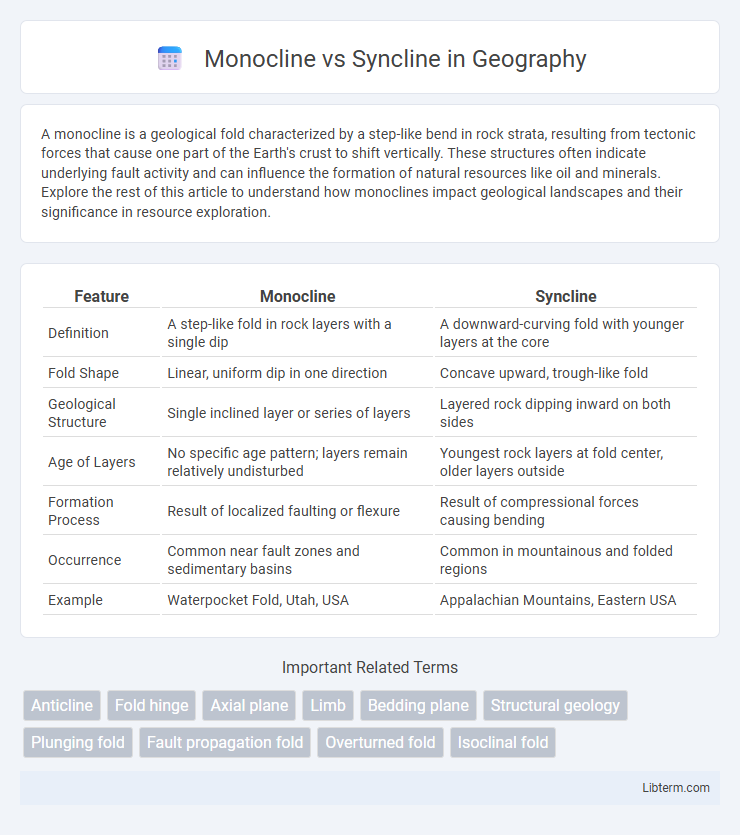A monocline is a geological fold characterized by a step-like bend in rock strata, resulting from tectonic forces that cause one part of the Earth's crust to shift vertically. These structures often indicate underlying fault activity and can influence the formation of natural resources like oil and minerals. Explore the rest of this article to understand how monoclines impact geological landscapes and their significance in resource exploration.
Table of Comparison
| Feature | Monocline | Syncline |
|---|---|---|
| Definition | A step-like fold in rock layers with a single dip | A downward-curving fold with younger layers at the core |
| Fold Shape | Linear, uniform dip in one direction | Concave upward, trough-like fold |
| Geological Structure | Single inclined layer or series of layers | Layered rock dipping inward on both sides |
| Age of Layers | No specific age pattern; layers remain relatively undisturbed | Youngest rock layers at fold center, older layers outside |
| Formation Process | Result of localized faulting or flexure | Result of compressional forces causing bending |
| Occurrence | Common near fault zones and sedimentary basins | Common in mountainous and folded regions |
| Example | Waterpocket Fold, Utah, USA | Appalachian Mountains, Eastern USA |
Introduction to Monocline and Syncline
Monoclines are geological folds characterized by a step-like bend in otherwise horizontal rock layers, resulting in a distinct incline in one direction. Synclines are downward-curving folds where rock strata dip inward from both sides toward a central axis, forming a trough-like shape. Both structures are fundamental in understanding sedimentary rock deformation and regional tectonics.
Definition of Monocline
A monocline is a geological fold characterized by a step-like bend in otherwise horizontal rock layers, where strata dip uniformly in one direction between two flat or gently inclined sections. It contrasts with a syncline, which is a fold with layers dipping inward toward a central trough. Monoclines often result from faulting at depth that deforms overlying sedimentary layers without breaking them.
Definition of Syncline
A syncline is a geological fold characterized by layers that dip inward from both sides toward a central axis, forming a trough-like structure. Unlike monoclines, which involve a single bend or step-like fold in rock layers, synclines exhibit downward curving strata with the youngest rocks typically found at the core. These folds play a significant role in sedimentary basins and oil trap formations due to their concave structure.
Geological Formation Processes
Monoclines form when rock layers undergo bending due to differential subsidence or fault reactivation, creating a step-like fold with a single inclined limb. Synclines develop through compressional forces that cause rock strata to fold downward into trough-like structures with both limbs dipping toward the fold axis. These distinct folding mechanisms reflect variations in tectonic stress regimes and sedimentary basin evolution.
Structural Differences Between Monocline and Syncline
Monoclines are characterized by a step-like fold with one limb remaining relatively horizontal, while synclines present a trough-like fold with both limbs dipping towards the fold axis. The hinge line in a monocline marks a zone of flexure connecting horizontal or gently dipping strata to steeper strata, contrasting with synclines where strata dip inward symmetrically. Structural difference lies in vertical displacement in monoclines versus concave curvature in synclines, shaping distinct geological formations and stress distributions.
Visual Identification and Field Recognition
Monoclines are characterized by a single, steep bend in otherwise horizontal or gently dipping strata, creating a step-like fold that is visually distinct in outcrop or aerial views. Synclines form trough-like folds where rock layers dip inward towards the fold axis, often recognizable by younger strata exposed at the center in cross-sections or valley landscapes. Field recognition of monoclines involves identifying localized flexures without amplitude repetition, while synclines exhibit symmetrical or asymmetrical downward curving beds with clear stratigraphic thickness variations.
Examples of Monocline Structures Worldwide
Monocline structures, characterized by a step-like fold in rock strata, are exemplified by the Waterpocket Fold in Capitol Reef National Park, USA, and the Grand Hogback in Colorado. These monoclines occur where horizontal layers are bent due to underlying fault activity, contrasting with synclines, which feature downward-curving folds forming troughs. The Himalayan foothills also exhibit monocline formations, demonstrating their global geological significance.
Notable Syncline Examples in Geology
Notable syncline examples in geology include the Appalachian Mountains, where vast synclinal structures contribute to the region's folded sedimentary layers. The Zagros Mountains in Iran showcase prominent synclines formed by tectonic compression during the collision of the Arabian and Eurasian plates. In contrast, monoclines are characterized by step-like folds with a single limb, such as the Waterpocket Fold in Utah, which differs from the symmetrical troughs typical of synclines.
Importance in Geological Mapping and Exploration
Monoclines and synclines are critical structural features in geological mapping that influence the distribution of rock layers and mineral deposits. Monoclines, characterized by a step-like fold with a single inclined limb, help geologists identify fault zones and potential hydrocarbon traps, while synclines, which are trough-like folds with layers dipping inward, often indicate sedimentary basins rich in groundwater and fossil fuels. Accurate identification of these folds enhances exploration efficiency by guiding drilling strategies and resource extraction in complex geological settings.
Monocline vs Syncline: Summary Table and Key Differences
Monoclines are geological folds characterized by a step-like bend in rock layers, whereas synclines are trough-like folds with layers dipping inward toward the fold axis. The summary table contrasts monoclines' single flexure and asymmetrical form against synclines' symmetrical, downward-curving structure. Key differences include monoclines' association with faulting and localized deformation, while synclines typically form in regional compressional regimes affecting extensive strata.
Monocline Infographic

 libterm.com
libterm.com